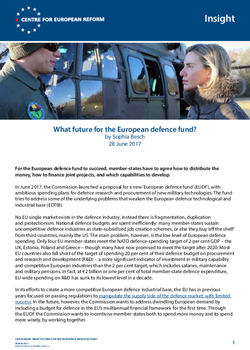
What future for the European defence fund?
For the European defence fund to succeed, member-states have to agree how to distribute the money, how to finance joint projects, and which capabilities to develop.
In June 2017, the Commission launched a proposal for a new ‘European defence fund’ (EUDF), with ambitious spending plans for defence research and procurement of new military technologies. The fund tries to address some of the underlying problems that weaken the European defence technological and industrial base (EDTIB).
No EU single market exists in the defence industry, instead there is fragmentation, duplication and protectionism. National defence budgets are spent inefficiently: many member-states sustain uncompetitive defence industries as state-subsidised job creation schemes, or else they buy ‘off the shelf’ from third countries, mainly the US. The main problem, however, is the low level of European defence spending. Only four EU member-states meet the NATO defence-spending target of 2 per cent GDP – the UK, Estonia, Poland and Greece – though many have now promised to meet the target after 2020. Most EU countries also fall short of the target of spending 20 per cent of their defence budget on procurement and research and development (R&D) – a more significant indicator of investment in military capability and competitive European industries than the 2 per cent target, which includes salaries, maintenance and military pensions. In fact, at €2 billion or one per cent of total member-state defence expenditure, EU-wide spending on R&D has sunk to its lowest level in a decade.
In its efforts to create a more competitive European defence industrial base, the EU has in previous years focused on passing regulations to manipulate the supply side of the defence market, with limited success. In the future, however, the Commission wants to address dwindling European demand by including a budget for defence in the EU’s multiannual financial framework for the first time. Through the EUDF the Commission wants to incentivise member-states both to spend more money and to spend more wisely, by working together.
What does that mean concretely? From 2020 the Commission wants to spend €500 million a year on defence research. That would make the EU the fourth biggest funder of defence research in Europe, after the UK, France and Germany. To test the waters, before the fully-fledged fund is launched, the Commission plans to spend a total of €90 million over the next three years, and has allocated €25 million for 2017 already. Only collaborative projects that involve at least three member-states – and as many as eight after 2020 – will be eligible to receive EU research funding.
No #EU #SingleMarket in defence industry, instead fragmentation, duplication and protectionism
The Commission also wants to support joint capability development. The EUDF aims to provide €500 million from 2019, rising to €1 billion annually from 2020, in co-financing for new military prototypes, taking on 20 per cent of the member-states’ financial burden in the development phase. Only projects involving at least three companies from at least two member-states will be eligible. The Commission hopes that by providing initial funding, it will incentivise member-states to invest larger sums: Commission Vice-President Jyrki Katainen has said that he expects each euro of EU investment to bring in five euros from national governments for new joint projects. Finally, in an effort to link the EUDF with other recent EU defence initiatives, the Commission is also offering countries that want to take part in permanent structured co-operation (PESCO – a kind of ‘defence eurozone’ that allows a subset of the EU’s 27 members to work together more closely, agreed by member-states at the European Council in June) an additional 10 per cent bonus on EU co-financing of joint capabilities.
European member-states and the European Parliament have to approve the Commission’s proposal. Initial reactions have been positive. The leaders of the main political groups in the European Parliament, the centre-right EPP and the liberal Alde have come out in support of the EUDF, as have defence ministers in France and Germany. But beyond initial support, agreeing on the details of the EUDF will be difficult. Questions will arise over what types of capabilities they aim to develop, over the distribution of the EU’s funds, and over how exactly EU member-states will finance joint capabilities.
First, for the impact of the EUDF, it is important not just how capabilities are funded, but also which capabilities the EU chooses to focus on. The 2017 EU Global Strategy (EUGS) sets out an ambitious agenda for defence. It states that the EU should contribute to responding to external conflicts and crises, building the capacities of partners, and protecting the Union and its citizens. The EUDF can only live up to its potential if it funds the platforms that are necessary to implement the EUGS’ ambitions in the future.
To translate these ambitions into capability needs, the Commission has concluded a ‘delegation agreement’ with the European Defence Agency (EDA). The EDA manages the so-called Capability Development Plan (CDP), which outlines capability priorities that member-states have agreed to jointly invest in. But member-states never allowed the agency to become what it was designed to be. Instead of delegating real responsibility or funds to the EDA, governments blocked it from working on ‘hard defence’, meaning high-end capabilities for fighting in the most dangerous and demanding wartime scenarios. The EDA’s budget has stayed frozen at €30.5 million from 2010-2015, and was increased to only €31 million in 2016. By contrast, the UK MOD oversees a ten-year equipment plan of £178 billion.
Initial reactions have been positive but agreeing details of the EUDF will be difficult
Member-states, defence industry representatives and the Commission disagree over the future role of the EDA. Some in the Commission question whether the EDA has the resources to handle the influx of new money from the EUDF, or do not want to limit the Commission to supporting defence capability projects identified in the CDP. On the other hand, some in the industry fear that the Commission looks at defence as just another piece of the internal market, and think that the EDA could resist ill-considered Commission ideas on defence industrial strategy. The EDA is set to review the CDP in 2018. For the EUDF to succeed, member-states would have to agree to include more ambitious priorities for joint defence development, such as for example a European military transport helicopter programme, or a maritime patrol aircraft programme.
Second, some European governments are asking the Commission which enterprises will benefit from the EUDF. Member-states that do not host one of the main European defence contractors, including BAE Systems, Airbus, Finmeccanica, Thales and Rheinmetall, are sceptical of the EUDF. They worry that the fund will further consolidate the market around the large firms and push out small and medium-sized enterprises (SMEs). SMEs are often sub-contractors in European defence supply chains. In parallel to the EUDF, the Commission aims to help them participate in cross-border projects by providing tailored funding from the European Investment Bank and European Structural and Investment Funds. It will have to find ways to make joint European procurement procedures more easily accessible for SMEs, if it wants the support of all member-states.
Third, it is not yet clear how member-states will finance joint capability development after 2020. The Commission wants to create an umbrella structure that can help finance joint projects at low interest rates by relying on government guarantees. It has floated the idea of European defence bonds or a European Stability Mechanism (ESM) for defence. An ESM that could make defence capability acquisitions on behalf of the member-states would help align spending plans in the future and overcome different budgetary cycles, an important obstacle to joint acquisitions. A structure that allows the EU to pool capital and raise money from private markets could lead to considerable efficiency gains in defence procurement. The Commission also wants to exclude money spent on joint capability development and procurement from calculations of national budget deficits; that way countries that invest in defence would not be penalised by the rules of the Stability and Growth Pact for increasing their deficits.
These plans are very likely to encounter opposition from some member-states, above all Germany. The German finance ministry in particular opposes any financing mechanism for common defence plans that pools liabilities in Europe and weakens Europe’s rules on budget deficits. The German defence minister's initial enthusiasm should not be taken as whole-hearted German support for the Commission proposal; further negotiations between ministries in Berlin and between Germany and other EU members inevitably lie ahead.
Finally, what does the defence fund mean for the UK? In spite of the many uncertainties over the future of the EUDF, UK defence firms take the Commission proposal seriously, and wonder what Britain’s position will be after it has left the EU.
Despite #Brexit, UK defence firms take the Commission EUDF proposal seriously
While some UK-based defence firms might try to access Commission research funding by opening subsidiaries in EU member states, for British firms to maintain their ability to tender for the resources of the EUDF the UK will probably have to continue to pay into the EU’s wider research programmes. The UK is one of the biggest beneficiaries of Horizon 2020, the EU’s current research fund, and British Prime Minister Theresa May has suggested previously that the UK might be willing to pay for access to the EU’s research programme after Brexit. The EU has an interest in retaining the UK’s contribution to R&D funds after Brexit, and the size and technical know-how of the UK defence sector mean that cutting all ties would be a loss for both sides. And there is also political will on the side of the Commission's Brexit negotiator Michel Barnier to tell some positive ‘Brexit stories’ – defence co-operation could be one of them.
Beyond research co-operation however, once outside the EU the UK would have a limited role in joint procurement. The UK could seek a Norway-style administrative agreement with the EDA. It would not have full voting or veto rights, but could contribute to EDA projects and attend some committee meetings. Britain would prefer to draw up a bespoke arrangement with the agency, to gain more influence over the choice of projects the EDA is pursuing and steer it away from those it disapproves of. But because the UK has often been obstructive with regards to the EDA budget in the past, the EU-27 have reason to be cautious when it comes to drawing up an association agreement. And the Commission in its proposed EUDF regulation has been clear that only EU member-states should be able to benefit from EU budget support. This affects not just the UK, it leaves Norway and other third states in a difficult position as well. Britain is leaving the EU at a time when the EDTIB might become both more ambitious and more exclusive.
Of the many EU defence initiatives of the last year, the defence fund is among the most interesting, because it addresses the lack of capabilities that is at the heart of many of the EU’s defence travails. The EUDF comes at a time of great political will to strengthen the EDTIB – there is a remarkable consensus that Europe’s security situation is becoming less predictable and Europeans can no longer exclusively rely on others for protection. The June European Council Conclusions welcomed the Commission's EUDF proposal, noting that member-states were ‘looking forward to its swift operationalisation’. But the Commission money can help only if it results in capabilities that enable Europeans to realise the strategic ambitions they laid out in the EUGS. A long road lays ahead still for the European defence fund.
Sophia Besch is a research fellow at the Centre for European Reform.


Add new comment